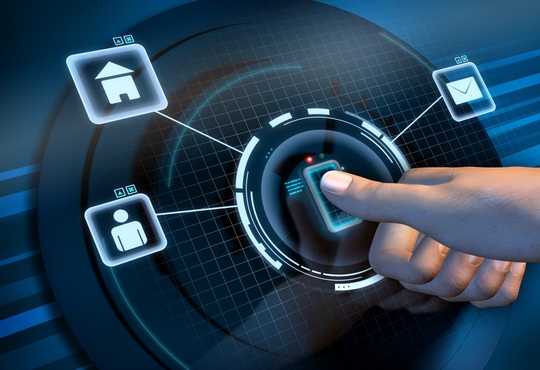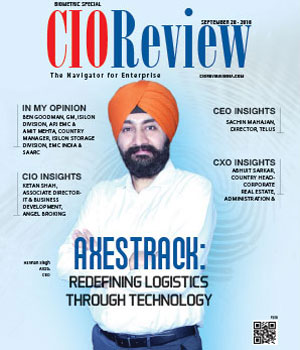
Unisys Survey Finds Wearable Technology to Revolutionize Biometrics; Privacy Issues Yet to Be Addressed
CIOReview Team | Wednesday, 24 August 2016, 09:00 IST
 New research from Unisys Corporation (NYSE: UIS) reveals that law enforcement is expected to lead the incorporation of biometrics into wearable technology. However privacy concerns around the security of biometric data stored in the cloud need to be addressed as adoption becomes more mainstream.
New research from Unisys Corporation (NYSE: UIS) reveals that law enforcement is expected to lead the incorporation of biometrics into wearable technology. However privacy concerns around the security of biometric data stored in the cloud need to be addressed as adoption becomes more mainstream.
The survey of 54 biometrics professionals was conducted by Unisys at the Biometrics Institute Asia Pacific Conference held in Sydney, May 24-26, 2016.
Wearable technology are devices or computers that can be worn on the body and typically have communications functionality, enabling data to be exchanged between a network and the device. Biometrics refers to a variety of technologies in which unique attributes of people are used for identification and authentication such as a fingerprint, iris print, hand, face, voice or gait.
“While biometrics have become cheaper, more accurate, and easier to use, the lack of revolutionary change in capture technology has constrained both the types of applications that employ biometrics and types of biometrics used in those applications. But the emergence of wearable technologies has the potential to turn the application of biometrics on its head,” said John Kendall, director border and national security programs, Unisys.
The majority of surveyed biometric professionals, 63 percent, say that enabling law enforcement and security officers to identify known or suspected criminals or terrorists is the most appropriate opportunity to incorporate biometrics into wearable technology – with far less support for consumers using smart watches to authenticate payments (19 percent) or using biometrics to control access to data captured by wearable devices (14 percent).
“Body worn cameras that clip onto uniforms like a badge, are already being used by law enforcement agencies globally to identify persons of interest by matching against a watch list and notifying the wearer via a smart phone or discreet Bluetooth earpiece,” said Kendall.
Respondents say facial recognition is the most appropriate biometric modality for wearable technology, followed by voice identification. And wristbands (52 percent), watches (19 percent) and lapel badges (15 percent) are the wearable formats best suited for biometrics.
“Many traditional biometric modalities, such as finger, face, iris and voice, can be readily applied to wearable formats. Fingerprint authentication is already accepted on smartphones and could be applied to watches and wristbands via fingerprint swipe sensors. Similarly, as many wearables already incorporate cameras, facial recognition is a logical choice for smart glasses and body worn cameras,” said Kendall.
Privacy concerns regarding access to biometric information stored on the cloud is cited as the most significant roadblock to incorporating biometrics into wearable technology (79 percent). Technology, format and cost are not generally viewed as impediments.
“As with most security measures, communication about how information is obtained, used and secured, for what purpose and for whose benefit, is key to gaining public acceptance,” said Kendall. “While there was some initial pushback against early smart glasses using facial recognition in consumer products, Unisys research has found the public will support facial recognition technology used by police and border security officers so we can expect to see these formats re-emerge in law enforcement applications.”
“However the really exciting future is in radically new biosensors that will transcend the limitation of today’s ‘smart accessories’ to enable practical applications for an entirely new class of non-traditional biometrics,” explained Kendall. “These include smart clothing – from underwear to shirts and jackets – that has conductive threads to enable the detection, transmission and protection of electrical signals, effectively turning the clothing into a sensor. In the future, multiple sensors in clothing and other wearable formats will communicate with each other via the Internet to create a Wireless Body Area Network (WBAN) enabling the measurement of emerging biometrics such as electrical activity in brainwaves (electroencephalogram or EEG) or electrical activity in the heart (electrodiogram or ECG).”
“Embedded biosensors placed directly on or under the body surface are another key development. While these are currently used for monitoring medical conditions there are already patent applications for smart contact lenses with a display that can project images straight into the users’ eye. The possibilities are amazing,” explained Kendall.
Detailed Results:
|
What do you see as the most appropriate opportunity for incorporating biometrics into wearable technology? |
|
|
63% |
Used by law enforcement and security officers to identify known or suspected criminals or terrorists |
|
19% |
Used by consumers to authenticate payments made via a smart watch |
|
14% |
Used to control access to personal data captured by wearable technology (e.g. location or activity) |
|
4% |
Other |
|
What do you see as the most significant roadblock to incorporating biometrics into wearable technology? |
|
|
79% |
Privacy concerns regarding access to biometric information stored on the cloud |
|
6% |
Form factor of wearable devices don’t lend themselves to biometrics |
|
4% |
Current biometrics are not appropriate for wearable devices |
|
4% |
Cost of adding biometrics to wearable devices |
|
7% |
Other (cited: legislation, public perception, no existing consumer applications, durability) |
|
What do you see as the most appropriate biometric modality for wearable technology? |
|
|
67% |
Facial recognition |
|
15% |
Voice identification |
|
9% |
Fingerprint recognition |
|
7% |
Iris recognition |
|
2% |
Skull sounds |
|
0% |
Brain wave patterns |
|
What wearable formats are best suited for biometrics? |
|
|
52% |
Wristbands |
|
19% |
Watches |
|
15% |
Lapel badges |
|
10% |
Glasses |
|
2% |
Headphones |
|
2% |
Glove or finger |
|
0% |
Headbands, hats, underwear, shoes, necklaces or clothing |
CIO Viewpoint
Biometric Identification - A Promising Concept...
By Goutam Datta, VP - IT, ICICI Lombard
"Maximizing Efficiency and Reducing Spend in IT...
By Anindo Ganguly, AVP and Head, IT Infrastructure Practice, Sasken Communication Technologies
Mobile Architecture : Housing Security as a...
By Ram Kalyan Medury, CIO, Magma Fincorp
CXO Insights
Data Analytics from EMC Isilon's Perspective
By Ben Goodman, GM, Isilon Division, APJ EMC and Amit Mehta, Country Manager, Isilon Storage Division, EMC India & SAARC
Biometrics : Future of Authentication
By Abhijit Sarkar, Country Head-Corporate Real Estate, Administration & Facility, Sharekhan
Putting the Finance Industry's Security...







